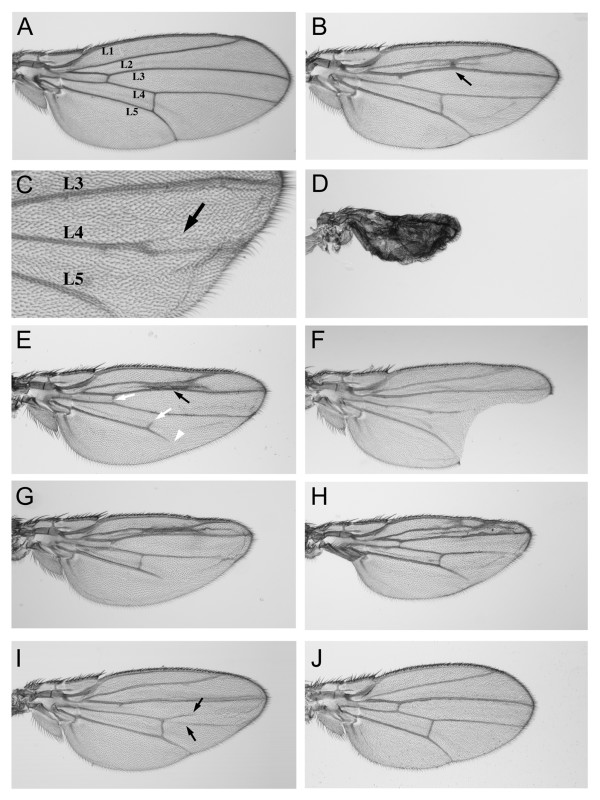Figure 6.
Wing phenotypes induced by overexpression of wild type and mutant DmKal-1 proteins in the wing disc. (A, B, E, G, H) Wings derived from flies emerged at 18°C. (A) MS1096-GAL4/+ control wing with designations of longitudinal veins (L1-L5). (B) MS1096-Gal4/+; UAS-kal-1/+; UAS-kal-1/+ wing shows a slightly shorter proximal-distal axis with a reduction of the L2-L3 intervein territory and a partial fusion of the L2 and L3 veins (black arrow). (C) Higher magnification of an MS1096-Gal4/+; UAS-kal-1/+ wing (25°C), with splitting of the L4 vein into anterior and posterior branches. The arrow indicates the anterior branch. (D) At 25°C, MS1096-Gal4/+; UAS-kal-1/+; UAS-kal-1/+ flies show a stronger phenotype with an extremely reduced wing. (E) MS1096-Gal4/+; UAS-kal-1 [N236K]/+ wing, which shows a partial fusion of the L2 and L3 veins (black arrow). The break of the anterior and posterior cross-veins (white arrows) and the reduction of the distal L5 vein (white arrowhead) are also found in the control. (F) At 25°C, MS1096-Gal4/+; UAS-kal-1 [R159T+R161L]/+ wing shows a notched edge between L3-L5 veins. (G) MS1096-Gal4/+; UAS-kal-1 [C127/128S]/+ wing. (H) MS1096-Gal4/+; UAS-kal-1 [C127/128S+N236K]/+ wing. (I) At 25°C, MS1096-Gal4/+; UAS-kal-1 [C85S]/+ wing shows a proximal-distal reduction and the splitting of the L4 vein (arrows). (J) At 25°C, MS1096-Gal4/+; UAS-Nrg180/+ wing shows a proximal-distal shortening. All wings are from females and they are oriented with anterior upwards and proximal to the left.

